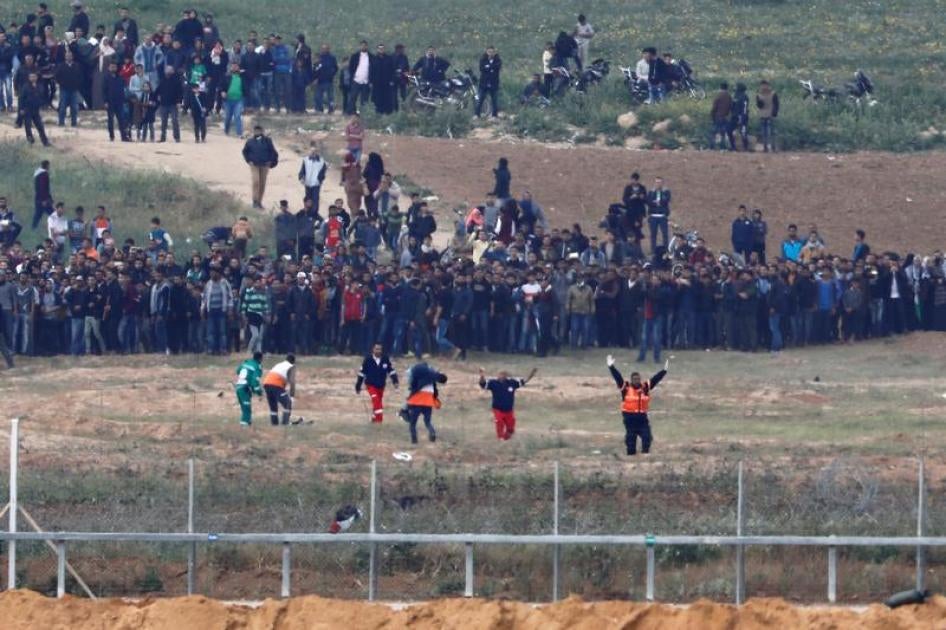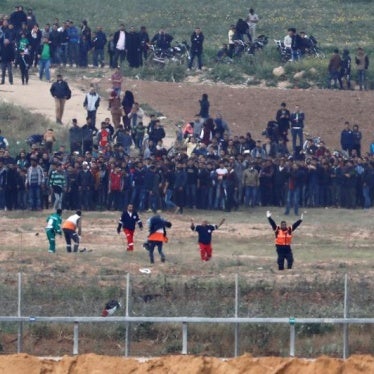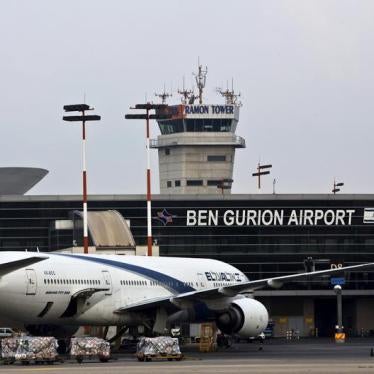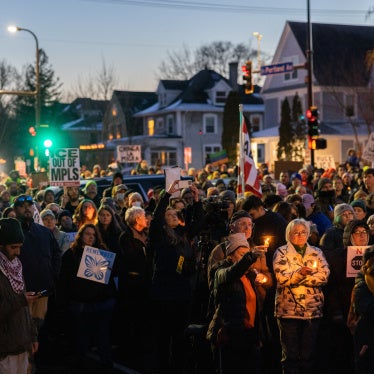Israel has a right to defend its borders, but shooting unarmed protesters who haven’t breached its frontier is disproportionate and illegal.
Since demonstrations began on March 30, Israeli soldiers have shot and killed more than 100 Palestinian protesters inside the Gaza Strip, near the border fence separating Gaza from Israeli territory. Israel’s government is responding to international criticism of the killings in Gaza with a line of argument it has used since the 2007 takeover of Gaza by Hamas. We regret the harm to Palestinians in Gaza, Israel is saying, but it’s unavoidable, because Hamas controls everything in Gaza, and we can’t act against Hamas without also harming protesters.
That’s the response Israel used until 2010 to defend punitive restrictions on the transport of goods, included some foods, into Gaza. That’s the response Israel uses to explain why it still blocks travel and prevents most of Gaza’s outgoing goods from leaving for external markets, two of the many restrictions that have driven unemployment in Gaza to 49 percent. And that’s the response that Israel has given, with official U.S. backing, to rebuff condemnation of its killing of more than 100 Palestinians and the maiming and wounding of thousands more, in seven weeks of demonstrations inside Gaza, near the Israeli border.
On Friday, the United Nations Human Rights Council voted 29-2 to create an independent investigation into the shooting, a resolution that Israel rejected as reflecting what it calls an anti-Israel bias of the council.
The Israeli government has already laid out its defense in a domestic court challenge brought by Israeli human rights groups. The government argued in a court briefing that “this is not a popular or spontaneous protest. These violent disturbances were organized, coordinated and directed by Hamas, a terrorist organization engaged in armed conflict with Israel.” A spokesman for the administration of U.S. President Donald Trump, Raj Shah, was quick to echo that argument last week: “The responsibility for these tragic deaths rests squarely with Hamas,” he said.
Certainly Hamas has supported the protests in Gaza, where its control is palpable. Criticism of Hamas rule can be punishable by arrest and torture, as Human Rights Watch has documented. Hamas reviews the sermons at Gaza’s mosques, and those sermons now tell worshipers to join the demonstrations at the Gaza border. On ordinary days, Hamas police officers prevent demonstrators from coming within 1,000 feet of the border fence inside Gaza, the distance that Israel has declared to be a “no go zone.” Since March 30, Hamas has allowed protesters through and hired buses to transport people to the demonstrations.
Some demonstrators said that Hamas representatives entered tents near the border and encouraged women to join the protests closer to the border fence. Hamas leader Mahmoud al-Zahar boasted in a television interview that the demonstrations had been bolstered by Hamas weaponry.
And yet the protests have grassroots origins and grassroots participation. They began with activist posts on Facebook calling for people to demonstrate on the 70th anniversary of the Palestinian Nakba (catastrophe) — the flight and expulsion of more than 700,000 Palestinians that accompanied Israel’s creation in 1948. The committee that is publicly responsible for organizing the demonstrations includes nongovernmental groups and representatives of the major political factions in Gaza, and protest activities have included family picnics and folk dancing.
Witnesses told Human Rights Watch investigators that most protesters were not searched, although there was at least one eyewitness report of Hamas security officials preventing a demonstrator from carrying a Kalashnikov rifle, apparently out of concern over escalation. Protesters reported seeing a small number of armed men at the demonstrations, and a larger number of people hurling rocks, including with slingshots; throwing firebombs; and launching kites with incendiary materials.
Yet under the international standards for policing demonstrations, even the use of rocks or firebombs does not justify lethal force, absent an imminent threat to life. It doesn’t matter whom the protesters support or who, if anyone, encouraged them to demonstrate. Lethal force can only be used when strictly necessary to protect against an imminent threat to life.
The Israeli government acknowledges the international law enforcement standard but says its forces will fire live rounds even before a threat to life becomes imminent, because it believes that Hamas will exploit the presence of thousands of demonstrators to breach the border fences. That essentially empties the word “imminent” of any meaning. It ignores the nonlethal means, such as tear gas, skunk water, and rubber-coated steel pellets, that Israel can and should exhaust to protect its border. Even if those methods were to fail (and they haven’t been exhausted), Israel would be justified in using lethal force only if a border breach presents an imminent threat to life. Israeli troops and snipers currently fire from well-fortified positions inside Israel, behind two fences, and, in key locations, behind ditches dug to prevent border crossings. They receive footage from drones hovering over Gaza and have backup from additional personnel and equipment located farther inside Israel. Since the protests began, Israel has reported only a single injury among its troops.
Human Rights Watch interviewed demonstrators who said they came to protest the U.S. Embassy move to Jerusalem peacefully and were shot by snipers far from the fences, which remain intact. Many demonstrators are young people who say they are protesting years of punitive travel restrictions that have devastated the economy and blocked access to schools, family visits, and medical care. Unemployment in Gaza is 65 percent among young people and about 80 percent among young women. The protests are not just at the Israeli border: Palestinian social media is buzzing this week over a video of a young man setting himself on fire in Gaza to protest the economic situation.
Israeli and American officials claim that Israel has no choice but to respond to the threat it sees from Hamas by lashing out at residents of Gaza, causing suffering, and even injuries and death. That has been the failed Israeli course of action, backed by the United States, since Hamas forcibly took control of Gaza in 2007 after winning a plurality of votes from Palestinians in East Jerusalem, Gaza, and the West Bank in 2006 and briefly sharing power with its rival, Fatah. Israel, which controls most of Gaza’s crossings, territorial waters, and airspace, and the border strip inside Gaza, sealed the crossings, allowing passage for people only under “exceptional humanitarian circumstances,” blocking outgoing goods, and limiting incoming supplies. With a few exceptions, Egypt has also closed its border with Gaza.
Until 2010, Israel counted the number of calories that Gaza residents would be allowed to consume, sorted by age and gender, and then used mathematical formulas to restrict the amount of food entering Gaza to no more than what Israeli officials deemed necessary. The Israeli government defended the restrictions as “economic warfare” aimed at weakening Hamas by restricting supplies to residents of Gaza and halting production and trade.
It had the opposite effect. Faced with these shortages, the Hamas regime in Gaza consolidated power, handing out food and cash to the poor, hiring the unemployed as public servants, and opening a lucrative trading system via tunnels underneath the border with Egypt.
By treating all Gaza residents, the majority of whom are children, as Hamas, Israel helped Hamas grow in strength. Hamas raised funds from taxes on tunnel goods, made people dependent on its largesse, and took over commercial trade, while ordinary people in Gaza were subject to punitive and unlawful restrictions on their freedom of movement.
The Israeli government is making a similar mistake now by treating all the protesters as agents of Hamas and then using lethal force against them, in the absence of an imminent threat to life. Hamas control over Gaza may pose a security threat to Israel, but it cannot justify unlawful acts by Israel against Gaza’s civilian residents.









